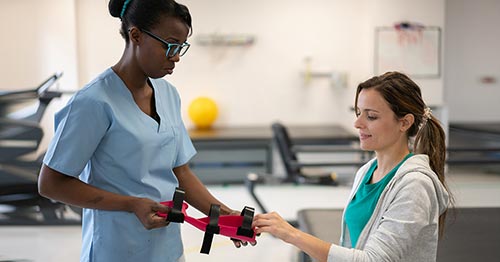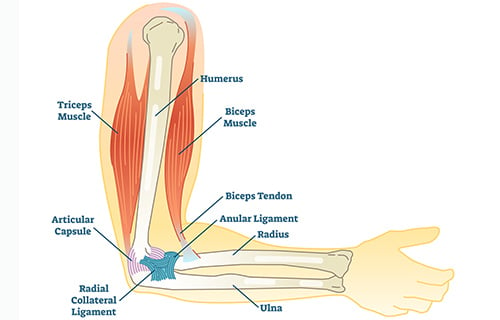Sports Injuries of the Hand, Wrist and Elbow
The benefits of regular exercise are well known. But sports activity is one of the leading causes of injury to the hand, wrist and elbow. They range from overuse injuries like tennis elbow and golfer's elbow to damage resulting from falls, such as skier's thumb and wrist sprains. Learn about some of the most common sports injuries that affect the upper extremities.

Understanding the upper extremity
Together the hand, wrist, and elbow make up the "upper extremity." Learning about the anatomy of each joint can help you better understand how it works and how you can best preserve its function and comfort for years to come.
Your hands are busy from the time you wake up and make your first cup of coffee in the morning to the time you go to bed and pull up the covers. The same may be said about the wrist, arguably the most complex joint in the body. And don’t forget the elbow, which enables you to feed yourself, brush your teeth, and get dressed each day.
Hand anatomy
Your hand contains 19 bones. There are 14 phalanges, the bones that make up each finger: three in each of the index, middle, ring, and pinky fingers and two in the thumb. There are also five metacarpal bones that make up the middle part of the hand. Numerous ligaments connect the bones to each other. Tendons connect muscles in the arm or hand to the bone to enable you to move your fingers. Sheaths are tubular structures that surround part of the fingers.
Your hands are essential for interacting with your environment. There are thousands of nerve endings in your fingertips. Arteries, veins, and nerves provide essential blood flow and sensation in the hand and fingers. This complex network can be challenging to navigate during surgery, requiring the expertise of an experienced surgeon.

Wrist anatomy
The wrist – the joint between your hand and arm – contains eight bones called carpal bones that are arranged in two rows. The scaphoid, lunate, triquetral, and pisiform bones move with the arm bones, and the trapezium, trapezoid, capitate, and hamate bones are connected to the bones of the palm. The carpal bones are connected by ligaments.
Many tendons connecting the forearm muscles to the fingers and thumb run through the wrist. Extensor tendons on the back of the wrist straighten your fingers, while flexor tendons on the front of the wrist bend them. Nerves and blood vessels also pass through the wrist. Together all of these structures work in a coordinated way to provide your wrist with exceptional range of motion.
Elbow anatomy
The elbow is the joint comprised of the end of the upper arm bone, called the humerus, and the two forearm bones: the radius and ulna. Your "funny bone" is the protrusion at the end of the ulna known as the olecranon. The joint is stabilized by ligaments at the front, back, and sides of the elbow. Muscles and tendons in the joint enable you to bend and straighten your arm and to rotate the forearm without moving the upper arm. The ulnar nerve runs through the elbow and into the forearm, along with a network of vital blood vessels.

What is skier's thumb?
Skier's thumb got its name because it's often seen in skiers who fall on the hand with the ski pole still in the hand, but it can occur among any athlete who falls on an outstretched hand – such as lacrosse or basketball players or baseball players sliding into a base. The ligament at the base of the thumb stretches or tears, leading to instability in the joint along with swelling, tenderness, and bruising.
If the ligament is only stretched or partially torn, you can get by with a splint for several weeks. If the ligament is completely torn and folds back on itself, it will need to be surgically re-attached, followed by wearing of a splint for six weeks to recover. Repairing this ligament is crucial to prevent lifelong instability of the thumb joint. Since the thumb is responsible for about 50% of hand function, permanent instability would make it difficult to perform simple tasks such as opening a jar or turning a key. Timely treatment is essential. At three months following the injury, an orthopedic surgeon may not be able to reattach the ligament and more complex surgery may be necessary.
You can protect your thumb when you ski by slipping your hand up through the strap and then lowering your grip around the pole, with the strap between your hand and the pole. If you fall, the pole will release but dangle from your arm so you won't lose it, and your hand will be protected. You can check to see how this works: open your hand and the ski pole should fall out. Baseball players can wear special gloves containing thumb protection for sliding into a base.
What is a wrist sprain?
In sports, a wrist sprain occurs when you fall on an outstretched wrist or stop yourself when running toward a wall. A sprain is a partial or complete tear of a ligament – in the case of wrist sprains, most often the ligament on the backside of your hand called the scapholunate ligament. Ligaments hold bones to bones, so when they are not intact, you'll experience instability in the joint accompanied by pain and swelling. If not treated correctly early in their course, sprains can lead to arthritis. Ligaments are also less resilient than other tissues so when they tear, they can take longer to heal.
If you injure your wrist, see a doctor or visit an urgent care center to have it checked out. The provider will examine your wrist, ask how you injured it, assess your range of motion, and order an imaging test such as an X-ray to see if there is a fracture. You'll likely need to wear a splint or cast to immobilize your wrist. If you don't feel better 7 to 10 days later, consult a hand surgeon for a more thorough evaluation. Treating a wrist sprain effectively within six weeks of the injury will give you the best chance of a successful outcome.
Surgery may be needed if you have a complete tear to repair the damaged ligament. Your recovery can be as little as two to three weeks or as much as three months for more serious sprains. Hand therapy is an important part of rehabilitation – whether your wrist has been immobilized or if you have surgery. The exercises are vital for regaining strength and range of motion.
What is tennis elbow and golfer's elbow?
These are tendonitis conditions that affect the two tendons of the elbow, and they result from overuse or playing with inadequate equipment. In the case of tennis elbow (lateral epicondylitis), the tendons that join the forearm muscles to the outside of the bony prominence of the elbow become inflamed. Golfer's elbow (medial epicondylitis) affects the tendons attaching the forearm muscles to the inside of the elbow.
In both cases, strain gradually causes microtears in the tendon, and the inflammation that results causes pain that can make routine activities such as dressing or cooking difficult, or even interfere with your sleep. In addition, as a tendon breaks down and repairs itself over time, scar tissue may form, which may make it harder to treat. Tennis elbow may result from putting top spin on the ball on your dominant side or "late hits," or from using a two-handed backhand on your nondominant side. Golfer's may also get tennis elbow on their nondominant side.
Treatment for tennis elbow and golfer's elbow
Most people get better with time and nonsurgical approaches such as rest, stretching exercises, a wrist splint or counter-force brace, and anti-inflammatory medications. Some patients achieve relief from symptoms through therapeutic ultrasound. Don't expect a quick fix, however: The tendons do not contain a lot of blood vessels, so when there are microtears, they can take six to nine months to heal. Cortisone shots are often prescribed, but these may not be the right choice for all patients. They may bring relief for one to two months, but there is no evidence they speed healing. A hand therapist or physical therapist may be able to guide you on how to move better to avoid these conditions and to prevent you from adopting compensating movements that may result in injury to other tissues.
If your symptoms persist after six to nine months, you may need surgery. For both conditions, the surgeon removes the section of damaged tendon tissue and reconnects the healthy tendon to itself and to the bone.
Tennis and golfer’s elbow surgery recovery
It can take three to four months to recover from the surgery, with splinting, physical therapy, and abstinence from the sport all playing a role in your rehabilitation regimen. If the irritated tendon compresses the ulnar nerve, the surgeon may repair that during the procedure as well. Your hand surgeon and hand therapist will discuss the goals of treatment with you.
Do you need to give up tennis or golf? The answer is probably not. There are things you can do to reduce your risk of tennis or golfer's elbow, such as:
- Playing with new tennis balls. You have to apply more force to hit old, worn-out balls.
- Don't string your tennis racquet too tightly.
- Avoid hitting the tennis ball late.
- Make sure you are gripping your tennis racquet or golf club properly; consult with an instructor or pro for guidance.
- If possible, play on a soft tennis court such as clay or grass.
- Shallow your golf swing so there is less shock in the arm when you take a divot.
- Avoid lengthy sessions hitting a golf ball off of a fake turf mat (such as at a driving range) or from a sand trap.
- Do exercises to strengthen your forearm muscles to take the load off your elbow. A therapist can guide you.
Preventing hand, wrist and elbow injuries
While many sports injuries will get better on their own, others are more serious. See an orthopedic specialist for a consultation sooner than later, when treatment brings the greatest chance of a good recovery.
Preventing a sports-related hand injury may not always be possible, but there are steps you can take to reduce their impact if they do occur. Stretching and strengthening exercises that protect the hands and wrists are simple to perform and do not require special equipment. Dr. Carlson advises anyone who participates in athletic activities to:
- Practice strengthening exercises on a regular basis.
- Always stretch before playing
- Refrain from playing while experiencing pain.
For stretching, try extending the arm with elbows straight, and curling the hand to move the wrists up and down. Individuals can build strength by squeezing a ball in the hand, doing wrist curls while holding a soup can or a light weight, or extending the fingers against the resistance of rubber bands placed around them.


